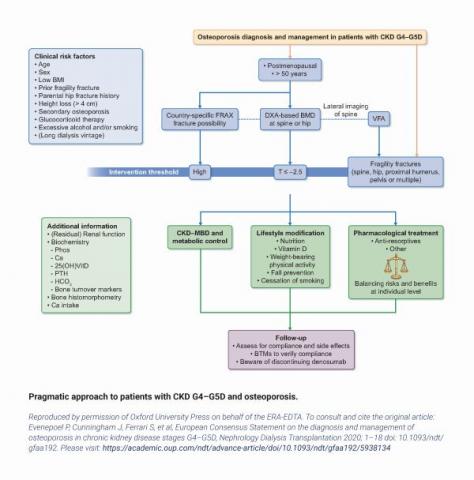Fracture prevention in advanced chronic kidney disease

The newly published 'European Consensus Statement on the diagnosis and management of osteoporosis in chronic kidney disease stages G4-G5D' addresses the unacceptable osteoporosis care gap in patients with chronic kidney disease (CKD) stages G4-G5D.
It outlines practical recommendations to support pro-active fragility fracture prevention in these high-risk patients, and also highlights the importance of coordinator-based fracture liaison services in systematically identifying and guiding CKD patients with fragility fractures, in close collaboration with nephrologists as part of the multidisciplinary team.
The Consensus provides recommendations for diagnosis, assessment of fracture risk, intervention thresholds, non-pharmacological and pharmacological intervention strategies, monitoring, and secondary fracture prevention through coordinator-based fracture liaison services.
Lead author, Dr Pieter Evenepoel, Department of Nephrology of the University Hospitals Leuven, Leuven, Belgium stated:
“Disturbances in mineral and bone metabolism occur early in the course of CKD and become almost universal in patients with advanced disease. Nevertheless, despite their very high risk of sustaining osteoporosis-related fractures, there is a vast osteoporosis care gap in these patients. Many clinicians are uncertain about the optimal diagnostic and therapeutic strategy and this may be fuelling inertia and a ‘wait-and-see’ approach in regard to osteoporosis care.”
The Consensus recommendations are timely and important given that chronic kidney disease is a rapidly growing problem worldwide. In 2010, 284 individuals per million population were estimated to be undergoing maintenance dialysis (CKD G5D) globally, and this is on the increase given the rapid increase in chronic cardiometabolic diseases.
Professor Serge Ferrari, co-author and Vice-Chair of the IOF Committee of Scientific Advisors, added:
“Recent studies suggest a similar efficacy of common osteoporosis drugs in patients with CKD G4-G5D as in the general patient population. We hope that the pragmatic consensus recommendations resulting from this successful collaboration between European societies, covering assessment, treatment and monitoring of bone health in renal disease, will serve to stimulate a proactive and cohesive approach to the management of osteoporosis in these high-risk patients.”
###
1. Evenepoel P, Cunningham J, Ferrari S, Haarhaus M, Javaid MK, Lafage-Proust MH, Prieto-Alhambra D, Ureña Torres P, Cannata-Andia J, European Renal Osteodystrophy (EUROD) workgroup, an initiative of the CKD-MBD working group of the ERA-EDTA, and the committee of Scientific Advisors and National Societies of the IOF, European Consensus Statement on the diagnosis and management of osteoporosis in chronic kidney disease stages G4–G5D, Nephrology Dialysis Transplantation, gfaa192, https://doi.org/10.1093/ndt/gfaa192